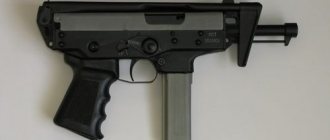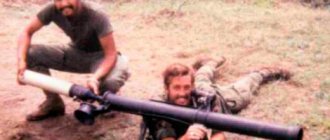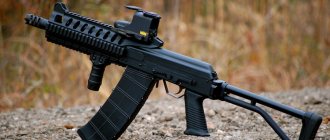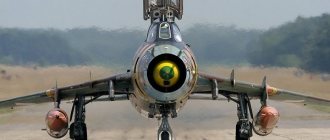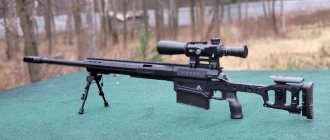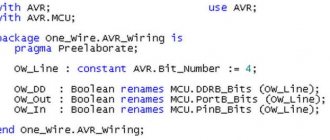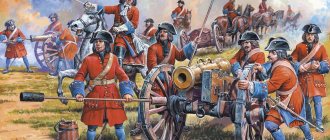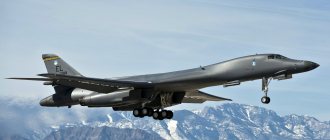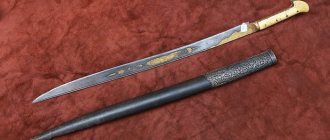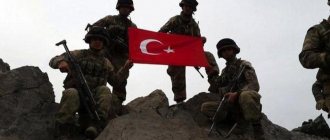The rifle belongs to the class of small arms with a rifled barrel. Its design involves the use of two hands to fix the weapon in weight and direct fire from it. In this case, the butt rests on the shoulder part of the body.
This type of weapon had different names in different eras. In the 17th century it was called a screw gun, then the name began to be used - shtutser (screw gun). Although the term “rifle” has been known since the time of the Pugachev rebellion, this name was officially introduced into the Russian army in 1856.
Rifle barrel length
Rifles can have a barrel of very different lengths, from 40 to 80 cm. Both long and short barrels have their advantages and disadvantages. When choosing barrel length, the following points should be taken into account:
- Longer barrels provide greater muzzle velocity. Although this increase in speed is not very large: an increase in the length of a rifle barrel by 10 cm leads to an increase in the initial speed of the bullet by only 3-4%.
- The longer the barrel, the more of the powder burns inside the barrel. This is why longer barrels have less muzzle flash. The muzzle flash, when shooting at night and in the twilight, severely blinds the shooter and does not give him the opportunity to fire a quick second shot.
- A shorter barrel is stiffer than a longer one, so it is less susceptible to vibration and provides slightly greater accuracy. The relationship between accuracy and barrel length is so insignificant that it can be ignored when using a rifle for hunting.
- A shorter barrel weighs less, provides better balance to the rifle, and is easier to carry and carry.
Most rifles have barrel lengths that are multiples of inches, so we talk about 20″, 22″, 24″ and 26″ barrels. Some manufacturers adhere to the metric system in the length of their barrels.
Most modern rifles in standard calibers have a barrel length of 22″ to 24″ (56 to 61 cm). There are more and more standard caliber rifles with 20″ (50 cm) barrels. Magnum caliber rifles most often have a barrel length of 24″ to 26″ (61 to 66 cm).
Air rifle laws
Let's start with the legislative framework so that we know what air rifles you can buy, how to transport them later, and where you are allowed to shoot from them.
There are three broad categories of air guns. They are divided according to the nominal muzzle energy of the shot:
- Up to 3 joules
- technically they are not weapons. Federal Law 150 “On Weapons” considers such rifles to be “structurally similar to weapons” and does not in any way limit their circulation and use. You can freely purchase and transport such rifles, and you can shoot them anywhere - naturally, observing safety precautions. But keep in mind that shooting from such a rifle in a crowded place or at living targets, transportation without a case and other socially dangerous manipulations may entail administrative liability under Article 20.1 of the Code of Administrative Offenses of the Russian Federation - this is petty hooliganism.
- From 3 to 7.5 joules
- these pneumatics are still sold freely, but they are already weapons, although not quite full-fledged ones. Federal Law 150 requires their owners to comply with the rules for transporting weapons, and also allows them to be fired only in specially designated places, that is, at shooting ranges and shooting ranges. In case of non-compliance with the rules, the owner faces liability under Articles 20.8 and 20.13 of the Code of Administrative Offenses of the Russian Federation.
- From 7.5 to 25 joules
— this pneumatic is sold only under license and is a full-fledged hunting weapon. It is subject to all the requirements for “adult” firearms.
Pneumatics with a muzzle energy of over 25 joules are prohibited for circulation in Russia and are not found on legal sale.
Let us remind you that any self-defense using air rifles is not only legally prohibited, but also extremely ineffective - choose something more suitable for self-defense.
Barrel caliber
The caliber of a rifled weapon is the diameter of the bore measured along the fields. Although in some countries, on the contrary, the caliber of the barrel is measured by the rifling. There are a huge number of different calibers of hunting rifles, but only a few of them are most widespread among hunters.
- 22LR is one of the most common calibers of hunting rifles, often called “small” by hunters. This type of cartridge was developed for initial shooting training, but due to its inexpensive cost and widespread use, it has gained great popularity among commercial hunters who use it to hunt fur-bearing animals and upland game.
- 22WMR - a cartridge of this caliber is similar to the previous one, but unlike it, it has more power and, accordingly, a longer range of an aimed shot. The 22WMR caliber cartridge can be used to hunt all types of game birds and fur-bearing animals.
- 223REM is one of the most common calibers of rifled hunting rifles, which has excellent characteristics in terms of power and shot range. One of the most versatile calibers, it can be used to catch all types of game birds, as well as small and medium-sized animals, up to the wolf.
- 243WIN is a rather interesting caliber, although not so popular among hunters in our country. The cartridge was created in 1955 for hunting coyote, white-tailed deer, and roe deer. The peculiarity of this caliber is that it allows you to shoot at a medium-sized animal at a long distance. The main caliber for use in mountain hunting.
- 308WIN is one of the most, if not the most popular caliber among hunters in our country. Allows you to fire a shot at a medium-sized and even large-sized animal at a distance of up to 300 meters. Has moderate recoil. There is a large selection of cartridges of this caliber in stores.
- 7.62-54R is a cartridge caliber of military origin, similar in characteristics to the 308WIN cartridge. Allows you to hunt medium and large sized animals. The letter R in the cartridge name indicates that the cartridge case has a protruding flange.
- 30-06 - is inherently the most powerful cartridge among 7.62 caliber cartridges, and is the most popular caliber in the USA. Caliber 30-06 sprg. is the progenitor of all 300 calibers. The very fact that this caliber has been used by hunters for more than a century speaks for itself. Caliber 30-06 is suitable for hunting ungulates and bear. Although many hunters successfully hunt smaller game with it.
- .300 Win Mag - cartridge developed in 1963 by the American company Winchester. The cartridge provides an initial bullet speed of up to 1000 m/s. The cartridge is well suited for hunting game weighing up to 350 kg: wild boar, deer, elk and bear.
- .300 Rem Ultra Mag - cartridge developed in 1998 by the American company Remington Arms Company. One of the most powerful cartridges for civilian weapons. Thanks to the large volume of the cartridge case and a light bullet of a small caliber, the cartridge provides an initial bullet speed of up to 1200 m/s, which ensures a flat trajectory of the bullet and high accuracy.
- 9,3×62 - a powerful caliber designed for hunting large game at short distances. It should be noted that the 9.3×62 caliber has quite noticeable recoil, and for many hunters shooting from a weapon of this caliber will not be very comfortable.
- 9.3×64 Brenneke is a powerful cartridge created in 1927 in Germany for hunting the African big five; in Russia it can be used for hunting wild boar, elk and bear.
You can learn more about rifled and smoothbore calibers in our article: Calibers: rifled and smoothbore, properties and application
New types of rifles and new ways to load them
A new stage in the evolution of the rifle began in the middle of the 19th century. It was characterized by the appearance of weapons loaded in the breech. Now the rifle could be loaded even while lying down. Among this type of rifle, the most famous were:
1) Dreyse needle rifle (1841). It already had a sliding bolt. But it was still imperfect due to the use of a paper cartridge.
2) Chasspo needle rifle. It was a successful invention of a new longitudinally sliding bolt mechanism for a rifle. Its design features were later used to modify these weapons.
3) In the Russian army, the second half of the 19th century is characterized by the use of rifles of various types. These are, first of all, the Karle and Carcano rifles and the Krik rifle. All of them were recycling of old weapons. In particular, from rifles loaded from the muzzle.
4) Quite a few high-velocity and multi-shot rifles are appearing in the USA. Thus, the Sharps rifle was created, which had a blade bolt. Then the Spencer rifle became widespread. It already had a crane valve. However, the Winchester Model rifle was especially popular. It was a lever action weapon.
5) The 7.62 mm rifle is becoming widespread in the Russian Tsarist Army. Its inventor was designer S.I. Mosin (1891). It was used by Russian and Soviet military units for over 50 years.
Number and length of rifling
The rifling in the barrel of a rifle allows the bullet to rotate as it leaves the barrel, resulting in increased shot accuracy. The number, direction of rotation, type and pitch of rifling vary from rifle to rifle.
The number of rifling in the barrels of modern weapons can be from 4 to 10. The greater the number of rifling, the higher the accuracy.
The rifling in the barrel of a rifled weapon can have either a right or left direction of rotation.
The grooves can have different profiles: rectangular, trapezoidal, triangular, oval. The most common are rectangular and trapezoidal rifling profiles.
The pitch of the rifling (twist) is the distance at which the rifling makes one full revolution. In Russia, the rifling pitch is indicated in millimeters, in Western countries in one turn per number of inches. A longer bullet needs a shorter (faster) rifling pitch, a shorter bullet needs a longer (slower) twist.
Minor Characteristics
These characteristics do not affect the accuracy and power of the shot, but the ease of use of an air rifle depends on them.
Store availability and capacity
The ability to immediately fire the next shot without being distracted by reloading is very attractive. But you have to pay for it by complicating the design, which means a decrease in reliability. PCP rifles are the most experienced in this matter: their food is most often magazine-fed and built on the principle of a revolving drum. Other schemes are less perfect and do not exclude sticking and jamming when feeding a bullet, so when buying inexpensive rifles it is better not to strive for multiple charges.
Fuse
Most modern air rifles have an automatic safety that blocks the trigger after cocking. Its importance can hardly be overestimated, especially if children or inexperienced shooters use the weapon - it will prevent them from shooting accidentally. If this is your case, then pay attention to the presence of a fuse - some models do not have one.
Weight
The less the rifle weighs, the easier it will be to operate, but the stronger the barrel toss and recoil will be when fired. In the case of low-power rifles up to 7.5 J, this is an insignificant factor. But when it comes to high-powered hunting rifles, heavy recoil can throw off the STP of a scope, especially if it's an inexpensive one.
It is worth paying attention to the weight when choosing a pneumatic gun for a child - some rifles weigh an indecent amount, even despite the miniature size of the stock.
Stock and stock material
As for the material from which the stock and butt of the rifle are made, everything is exactly the same as with an “adult” firearm:
- Plastic
practical and lightweight, you don’t mind scratching or hitting it, it’s easy to clean and doesn’t require special care. Its only drawback is that it looks too simple and cheap.
- Tree
- warm to the touch and looks much more substantial, but you have to pay for it with the extra weight of the weapon. Typically, inexpensive softwoods like bamboo or birch are used to make air rifle stocks, but beech and walnut can be used for high-end PCP rifles.
So, now you know everything you need to choose a good air rifle, all you have to do is go to the catalog and choose the option you like.
But if you are still undecided on your choice, then read our article about the five best air rifles for beginner shooters - we hope it will dispel your doubts! The reference article is based on the expert opinion of the author
Recharge principle
From the point of view of the reloading method, all rifles can be divided into two types:
- Bolt-action rifles have higher accuracy and shot accuracy, they are easy to clean and maintain, but they allow the hunter to quickly fire the next shot, which is extremely necessary for some types of hunting.
- Semi-automatic self-loading rifles - allow you to quickly fire the second and subsequent shots, but at the same time they have less accuracy and accuracy of the shot, and require more thorough cleaning and maintenance.
You can learn more about rifled weapons, their characteristics and properties in our article: Rifled weapons for hunting
Modern types of rifles
In modern conditions, armies around the world use a variety of rifles, which can be reduced to the following main types:
1) An automatic rifle is a firearm designed for individual use, using rifle-machine-gun ammunition. It is capable of firing both single shots and bursts. Since the end of World War II, the automatic rifle has become the main type of weapon for infantry units in the armies of many countries around the world.
2) A self-loading (semi-automatic) rifle is the same as an automatic rifle, but it is designed to fire only single shots. To fire a new shot, the fighter must lower the trigger each time in a new way with the next press.
3) A sniper rifle is a type of rifle that requires a delicate attitude. It is necessary to carefully follow the regulations for weapon maintenance (cleaning and lubrication). This rifle is used to hit targets at long distances. A type of sniper rifle is the screw cutter. It is designed to carry out silent firing at the enemy. It can fire in short bursts.
4) A carbine is an automatic rifle with a shortened barrel and lighter weight.
5) An air rifle is a weapon that uses compressed gas to push a charge out of a barrel. Mainly used in sports.
6) An anti-tank rifle (ATR) is a large-caliber rifle. Its main purpose is to combat armored vehicles.
What cartridges are suitable?
The cartridge for the “three-line” was developed by the Russian engineer Veltishchev. In his work, he used the cartridge for the French Lebel rifle as a basis. The bullet became blunt-pointed and shell-like. The sleeve was distinguished by a protruding bottle-shaped edge. The charge used smokeless powder.
It is interesting that the rim used in the sleeve was already part of an outdated production technology at that time. But the development of the military industry in Russia was at a low level, and the production of such cartridges required less technology.
It was only in 1908 that so-called “offensive” or pointed bullets began to be used for the Mosin rifle. This was preceded by years of foreign intelligence work, because the Germans developed and tested a new type of bullet back in 1905.
After much testing, it became clear that the pointed bullet was a real breakthrough in military affairs, since its performance was almost twice the range and speed of previous models.
Again, the economic component came first here. At first, the budget for innovation was so small that in the factory they changed the geometry of already produced blunt bullets.
The use of new cartridges required a number of upgrades to the existing rifle model. So, in 1910, the army began to receive a “three-line” with an installed Konovalov sight.
Mosin rifle modifications
The legendary “three-line” was so popular in the Russian and then Soviet army that the appearance of its various modifications is a completely natural phenomenon. Perhaps the most successful improvement to the rifle was the sniper model, which appeared in 1931.
The Mosin sniper rifle allowed targeted fire at a range of 1000-1300 meters. A 3.5x optical sight was installed to help the sniper. The installed optics did not allow constructively to provide a clip for five cartridges, which was installed on all production samples.
So a significant drawback of the sniper version was the ability to conduct only single fire.
After each shot a reload was required.
Only the best soldiers were recruited into sniper squads. After completing training, they received a Mosin sniper rifle, which could be produced in two versions. The first did not involve any improvements to the barrel. In fact, the standard “three-line” was simply equipped with a front sight and optics.
The second option was distinguished by modified characteristics of the intra-trunk space. This allowed for improved accuracy and range. But there were few such samples.
Interestingly, the “three-line” snipers were also equipped with a bayonet, which was attached more tightly and served more as a weighting agent for the barrel. During the tests, it became clear that, indeed, the bayonet in the combat position has a good effect on the accuracy of fire.
During the Great Patriotic War, handicraft modifications were very popular - the so-called sawn-off shotguns of the Mosin rifle. Most often they were used by partisans. They were made easily: they sawed off part of the barrel and butt. The weapon became compact, but the already low shooting accuracy became even worse.
At the end of the 20th century, the armed forces received an order to design a budget sniper model for the needs of the Ministry of Internal Affairs. The Tula residents took Mosin’s famous “three-line” as a basis.
After modernizing the trigger mechanism, adding a cheek and butt, and an additional handle, the result was a compact but inconvenient sniper model. A small batch of these rifles can still be found at the department’s disposal.
Rifle "Springfield" mod. 1903 (USA)
In 1903, the United States adopted a new cartridge .30-03 (cartridge caliber .30 model 1903), which was distinguished by a large powder chamber and the absence of a rim on the cartridge case. The bullet of the new cartridge had greater penetration and accuracy. Already in 1903, a repeating rifle was put into service, created by specialists from the Springfield Armory enterprise for the new ammunition.
Rifle "Springfield" mod. 1903
Structurally, it is similar to the Mauser rifle mod. 1898. The Springfield rifle has a rotating bolt of longitudinal movement, the barrel bore is locked by two front lugs and one rear one. There is a safety catch on the bolt. The weapon is equipped with a 5-round magazine loaded from a plate clip. The earliest rifles had a sector sight designed for use with blunt bullet cartridges.
In 1906, the Springfield .30-06 M 1903 rifle was adopted for service under the new .30-06 cartridges with a pointed bullet that had a higher initial velocity. The shape of the chamber, as well as the design of the sight, have been changed.
The experience of the First World War proved that an army of thousands received fairly cheap and effective mass-produced weapons.
In 1929, a modification of the M 1903 A 1 appeared with a pistol neck stock and a front sight protected by a cylindrical muzzle guard. During the Second World War, a modification of the M 1903 A 3 was created, characterized by the location of the diopter sight behind the receiver window and a stock with a straight neck. The sniper model M 1903 A 4, which appeared later, was equipped with a mount for an optical sight.
Serial production of Springfield rifles was also carried out by Rock Island Arsenal. Production ceased in 1919 (about 350,000 rifles were produced), until 1939 it produced more than 1.53 million rifles.
One of the first US combat units sent to Europe in 1917 to participate in the war was the Rainbow Division. The armament of American soldiers consisted mainly of Springfield rifles mod. 1903
The adoption by the US Army in 1936 of the M 1 Garand self-loading rifle (produced at Springfield Armory) had little effect on the rate of production of Springfield rifles, and with the entry of the United States into World War II, their production increased. In 1940, she began assembling rifles using components from Springfield Armory. In February 1942, the Smith-Corona enterprise, which previously produced typewriters, was connected to production. Until 1944, more than 1 million Springfield rifles were produced, 238,000 more. The total production volume was about 3.2 million rifles.
Springfield rifles were one of the main types of small arms of the US infantry until the end of World War II, and the M 1903 A 4 sniper modification was used during the Korean War.
Rifle "Lebel-Berthier" (France)
In 1890, the French army adopted the Berthier cavalry carbine chambered for an 8-mm cartridge from the Lebel rifle mod. 1886. The design of the carbine was radically different from the rifle. It had a convenient middle 3-round burst-loading magazine, and the bolt handle in the locked position was lowered down, rather than sticking out to the side, like a rifle. The Berthier carbine was one of the lightest, most compact and easy to use of all carbines of that time.
Rifle "Lebel-Berthier"
In 1907, the standard Lebel rifle mod. 1886 was radically reconfigured. She received the middle magazine and receiver from the Berthier carbine. The stock began to be made from a single piece of wood. The cartridge also changed - in 1905 a new 8-mm pointed bullet with a high initial velocity appeared. The new model used a bolt group, trigger mechanism and barrel from “Lebel” mod. 1886, so the new rifle received the designation “Lebel-Berthier” M 1907.
The rifle turned out to be very long and massive. The abandonment of the under-barrel magazine made it possible to speed up the reloading of the weapon, but the magazine capacity was too small. A solid, uncoated bullet, varnished with copper, often broke off the rifling when passing through the bore and lost balance in flight. The bullet material was also not the cheapest: an alloy of copper and zinc.
The French army approached the First World War with a serious lag in the field of infantry armament. The modernization of the Lebel-Berthier M 1907 rifle in 1915, which consisted only of improving the design of sighting devices, did not save the situation.
The next modification of the “Lebel-Berthier” M 1907/15 M 16 was a rifle mod. 1907/15 The serial production of this modification was mastered, as well as the conversion of all three-shot rifles that were in service to its standard.
A French soldier has breakfast at Royal Platz. A bicycle stands nearby, with a Lebel-Berthier carabiner leaning against it. Reims, April 1, 1917. In a few days, a grandiose Allied operation will begin in this area (going down in history as the “Nivelle massacre”), in which the Allied forces will lose up to 350,000 people killed and wounded in a month of fighting (180,000—French, 160 000—the British and 5,000 soldiers were lost by the Russian Expeditionary Force in France)
In 1931, a new 7.5 mm wafer cartridge became standard rifle ammunition. In 1934, the 7.5 mm Lebel-Berthier M1907/15 M 34 rifle appeared. It was a universal weapon similar to the German 98k carbine. The rifle was shorter and lighter than previous models and had a middle magazine for 5 rounds, which did not protrude beyond the dimensions of the stock.
In addition, a massive conversion of old rifles for new ammunition was organized. Until May 1940, the French, Manufacture Nationale d'Armes de Chatellerault (MAC) and Sodete Alsacienne de Constructions Mecanique (SACM) managed to supply several tens of thousands of such “alterations” to the army.
8-mm cartridges and rifles for them were used in large quantities by soldiers of the Vichy Army, Resistance fighters and soldiers of the Free French Army until the end of World War II.
Rifle "Mauser" mod. 1898 (Germany)
In 1885, the German gunsmith P. Mauser, who, with the assistance of his older brother Wilhelm, organized an armory, developed a 9.5-mm magazine rifle with a sliding bolt with a rotation when locked. In 1887, P. Mauser received an order from the German army to produce rifles adapted for the 7.92 mm cartridge. Subsequently, the design of the rifle underwent several minor upgrades, and in 1898 its most famous model appeared.
Rifle "Mauser" mod. 1898
The rifle is designed for a standard German 7.92 mm cartridge and is distinguished by a simplified bolt design, the absence of a barrel protective casing, and an accelerated method for filling the magazine. The pack clip is inserted into the magazine at any end. The barrel bore is locked by symmetrically located three bolt lugs. Disassembly and assembly of the shutter is carried out without the help of any tools. The safety lever has three positions: “fire”, locking one trigger (for disassembling the bolt) and locking the trigger together with the bolt.
Since 1923, the reorganized Reichswehr was equipped with the 98b carbine, completely identical in length and weight to the rifle mod. 1898 The weapon was equipped with a simplified sight. After expending the last cartridge from the magazine, the bolt did not close, which signaled the need to fill the magazine.
German infantry company armed with Mauser rifles mod. 1898, in a captured Belgian city, 1914
Design of the Mauser rifle mod. 1898 turned out to be very successful. The rifle was used in two world wars and was in service for a long time in more than 20 countries in Europe, Asia and South America. Mauser rifles were produced in many European countries; the total production volume is not known exactly, but it probably exceeds 20 million units.
Myths about “three-rulers”
The most famous and sad myth about the Mosin rifle can be called the history of the Second World War. During the tragic days of the Battle of Stalingrad, the shortage of weapons was so acute that one soldier sometimes received a clip, and another a “three-ruler.”
Later it became known that there were enough weapons, but many warehouses were not far from the border and were captured by the enemy in a matter of days at the beginning of the war. This sloppiness cost the country millions of dead.
Another story connected with the very beginning of the path of the legendary weapon happened with the creator of the rifle, S.I. Mosin. It is known that the French, having learned about some of the wonderful solutions that the designer included in his brainchild, offered him about a million francs for the project.
But Sergei Ivanovich showed patriotism and brought the development to completion, donating the “three-line” to his homeland.
Later, however, it turned out that Mosin himself received only 30 thousand rubles as gratitude. While Nagan, whose clip was added to the rifle, the Russian side paid 200 thousand.
They say that this fact greatly upset the Russian designer. He even wrote letters to management in the hope of receiving at least a commensurate reward, but everything turned out to be in vain.
